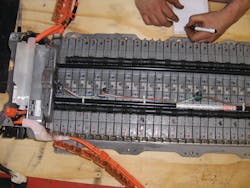Editor's Note: The following is a revised version of the March Tool Q&A on hybrid repairs. Hybrid technology is new and evolving. In the interest of accuracy, PTEN offers a revised version of the March article.
Q: What common tools do I need to get started?
A: Being that hybrids and electric vehicles (i.e. the Chevy Volt and Nissan Leaf) are made by mainstream companies, you will already have most of the tools you need. For example, hybrids generally have aluminum oil pans so you will need a torque wrench when tightening the drain plug. Even though the right scan tool with the appropriate OEM enhanced software is useful for any vehicle, it is absolutely necessary that the scan tool can communicate to the modules on a hybrid.
The list of tools to work on hybrids that you don't have is probably small, but you should consider purchasing them if you intend to work on these vehicles. Safety equipment, first! You will need high voltage "lineman's" gloves capable of withstanding 1,000V of shock. The serious hybrid shop should have a pull-hook that looks like, but is fundamentally different from the hooks they have near pools to save drowning people. It is the only safe means of saving someone from electric shock. Not every dealer has one of these, however.
You will also need to upgrade your electric meter. To work on hybrids, you need to be able to diagnose HV leaks in cables and in internal windings inside the transmission and inverter. Only a Category III certified meter capable of doing an insulation test can get the job done.
Q: What am I commonly looking at when using my scan tool?
A: With the right scan tool (either factory or an aftermarket tool with strong OEM enhanced software -- believe it or not good aftermarket scan tools appear to communicate better with some hybrids), there are not that many PIDs (Parameters Identifications) in datastream you need to look for. Usually we communicate with the HV Battery Module, whose name changes depending upon the manufacturer, look at a few PIDs that concern battery state of charge and other relevant parameters. For example, the Toyota Prius with a bad HV battery often has a dozen good battery cells at 14.5V or so and only a few low ones, causing the module to throw a code.
Keep in mind that a pack with over 14V is not necessarily good. A single failed battery cell (this is common in Honda hybrids) can make the whole HV "defective" and have the vehicle throw a code.
Don't forget to check out battery temperature and state of charge PIDs as well. If the HV battery is too hot (example: a temperature consistently 100 degrees F on a Prius during normal operation) because of a broken cooling fan or something of the sort, this can cause HV deterioration. Furthermore, we are going to want to look at the state of charge of the HV battery to see if the motor generator is charging the battery pack as a whole. For example, it might be shown as a percentage on a Prius, so we would be looking for percentage to increase during charging conditions, such as rolling the car. This is different on a Civic hybrid, where we'd want to see the battery module output to be at least 144V and increasing during charging conditions.
Some experts believe that it is necessary to look at the state of charge of the HV battery to see if the motor generator is charging the battery pack as a whole. State of charge is constantly changing. You want to look at amps in and out of the pack to determine charging, if that PID is available. If it is not being charged, the motor generator is the least likely culprit since the software shuts down charging for many hybrid failure codes. This will depend on the code and the vehicle. It is wise at this point to consult test plans provided from the OEM to inform you where to go next.
Always be sure when diagnosing these vehicles that the HV computer has the latest software. For example, Honda Civic hybrids with a good HV battery state of charge and an out of date calibration ID (fancy terminology for the version of software on the vehicle) need a software update as per a TSB. If you cannot read the PID, you cannot diagnose the IMA (Integrate Motor Assist) light problem on that vehicle and might be replacing an expensive battery instead of updating software.
Q: How can you rebuild a Toyota Prius' hybrid battery?
A: You can rebuild a hybrid battery by diagnosing which cells are bad. Then you can replace a bad cell with a known good cell. With the Prius, simply replace a Gen 1 cell with another Gen 1 cell, or a Gen 2 with another Gen 2 cell. Gen 1 cells have a lot of problems, so it is possible to change over the whole battery back of Gen 1 cells to Gen 2, but they cannot be mixed and matched.
These batteries can also be taken apart and load tested if necessary. Usually, not all the batteries go bad at once, just a few do, so with a load tester and a multimeter, you can compare the batteries to one another.
Here's how you test HV battery cells step-by-step:
- Check the voltage on each cell and make a notation on each cell that is below 6.9V to 7V. (Figure 1)
- Put a normal battery charger on any of the low voltage cells at the lowest setting possible for about 20 seconds. The moment that HV battery cell feels a little warm (not hot, warmer than room temperature), stop charging. Note: The battery cells' ground and power sides will flip flop, so be sure to connect your charger properly.
- Load test each HV battery cell with a simple load tester. They should hold for about five seconds before the voltage dips down. Simply compare the cells to one another. The bad ones really stick out. (Figure 2)
- Replace the bad battery cells with known good cells (from a junkyard HV battery, for example).
Gen 2 battery cells can be used in place of Gen 1 cells on a Gen 1 Toyota Prius. If you don't want a comeback on a Gen 1 battery, it is best to change over every single battery cell with a Gen 2 battery cell. Believe it or not, this works like a charm; it's the HV battery rebuilder's secret.
Some experts question the validity of rebuilding HV battery packs at all and have brought up the following concerns:
- There is no perfect method to test individual battery cells. Some experts also claim you cannot use terminal voltage to determine the state of health or the performance of a nickel battery.
- Profession HV battery rebuilding companies test cells using a power test and an energy test. A power test will load the batteries to determine battery internal resistance while the energy test will load the batteries to determine battery capacity.
It is recommended only to attempt this procedure after proper hands-on training.
Q: Is it worth tooling up for hybrid service?
A: This is a tough one. A hybrid customer is not exactly a big-spending customer. After all, he spent money on a car purely so he can save money on gas, so who says he wants to spend a lot on repairs? Furthermore, hybrids do not need frequent brake or transmission service either. They are not a huge moneymaker unless you can corner the market on HV battery and transmission rebuilding. However, it is always good business not to send work back to the dealer. Also, more importantly, most tools you use for hybrid service cross over to other vehicles.
Q: What common tests can I do with my meter?
A: Hybrids require the same sort of voltage drop testing as a regular car. For example, a Toyota Prius HV battery often just has an issue with the copper bus bars corroding, causing internal voltage drops in the HV battery. (Figure 3) As you can see in the picture, ultrasonically cleaning this in the Launch X-SonicClean did the trick. For demonstrative purposes, we cleaned half the corrosion off the copper bus bar so you can see before and after.
The one special test you will need to know is an "insulation test," which requires a MegOhm meter capable of sending a high voltage pulse. Be aware of the capabilities of your insulation tester. Some experts say using 1,000V on a system that should be tested at 500 or 250 volts can damage the electronics in the system being tested. Make sure to check your tool's settings before doing any tests.
This is how it works: Connect one meter lead on the ground for the HV cable/motor generator/etcetera and the other on the power side. Then, conduct the insulation test. Your reading should be about 2.2 gigohms on a Honda. If you have anything less, such as 5.4 million ohms, then you have an HV leak somewhere such as shorted windings in the motor generator. This requires a transmission rebuild to repair. The insulation test might be the only means you have to prove to the customer that their HV DTC can be repaired by a big money repair.
Q: Do I really need training?
A: At a minimal, you will need safety training. You don't let an employee who is brand new in the industry set a lift or do a brake job until you properly train him first, correct? In the same way, you need to have a thorough understanding of electricity and model-specific safety precautions before you do any serious work on these vehicles.
Even to do an oil change on a Prius you need to disable the smart key so the vehicle will not start itself up in the air if the vehicle has not been turned off, which is hard to tell for some people being that the vehicle in auto-stop mode does not make noise. If you don't get at least a day of hands-on training on hybrids, you probably should not work on them. It's not worth the risk. Remember, if the vehicle powertrain has powered down, the vehicle will not restart unless commanded to do so.
Q: Are there other methods to repair hybrid vehicles?
A: Of course. Many of the strategies are taught by training organizations, but they are not the only methods to diagnose and repair vehicles.
Different industry experts come from varying perspectives. For example, one trainer may have a different method of testing used HV battery cells using ohms or some other means. Another may recommend only buying a new HV battery from the dealer as required in OEM test plans and a hybrid battery rebuilder/manufacturer will have their own proprietary methods they feel is best.
The recommendation of Professional Tool and Equipment News is to always use the safest method available and to employ strategies that help you fix real vehicles in your shop. Always use discretion when employing new diagnostic strategies and repair techniques.
Have questions? Need answers? Email [email protected] to have your questions answered in this column.

